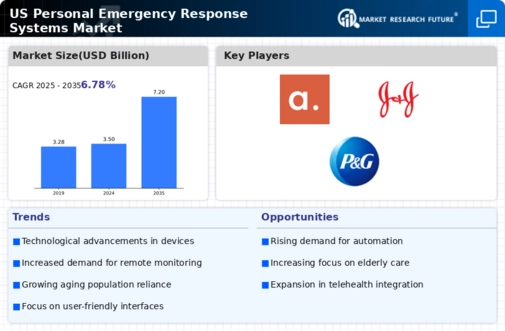Rising Healthcare Costs
The escalating costs associated with healthcare are influencing consumer behavior in the personal emergency-response-systems market. As individuals seek to mitigate potential health emergencies, the demand for proactive solutions has intensified. Many consumers view personal emergency-response systems as a cost-effective means of ensuring their safety and well-being, particularly for the elderly population. Market analysis indicates that nearly 60% of consumers are willing to invest in emergency-response systems to avoid higher healthcare expenses in the future. This trend suggests that the personal emergency-response-systems market is positioned to grow as more individuals recognize the financial benefits of investing in preventive safety measures. Consequently, manufacturers may focus on developing affordable yet effective solutions to cater to this cost-sensitive demographic.
Technological Integration
The integration of advanced technologies into personal emergency-response-systems is transforming the market landscape. Innovations such as GPS tracking, mobile applications, and wearable devices are enhancing the functionality and appeal of these systems. For instance, the incorporation of real-time location tracking allows users to receive immediate assistance, significantly improving response times. Market data suggests that the adoption of smart technology in emergency-response systems has increased by over 40% in the past two years. This technological evolution not only attracts tech-savvy consumers but also positions the personal emergency-response-systems market as a leader in the safety technology sector. As technology continues to advance, the market is expected to expand further, driven by consumer demand for more sophisticated and user-friendly solutions.
Increased Awareness of Safety
The heightened awareness surrounding personal safety and emergency preparedness is a crucial driver for the personal emergency-response-systems market. As individuals become more cognizant of potential risks, the demand for reliable emergency-response solutions has surged. This trend is particularly evident in urban areas, where crime rates and health emergencies are more pronounced. According to recent surveys, approximately 70% of households express a desire for enhanced safety measures, indicating a robust market potential. The personal emergency-response-systems market is likely to benefit from this growing emphasis on safety, as consumers actively seek out systems that provide immediate assistance in emergencies. This awareness not only drives sales but also encourages innovation within the industry, as companies strive to meet the evolving needs of safety-conscious consumers.
Regulatory Support and Standards
Regulatory frameworks and standards play a pivotal role in shaping the personal emergency-response-systems market. Government initiatives aimed at enhancing public safety have led to the establishment of guidelines that promote the use of emergency-response systems. For example, recent legislation has mandated the inclusion of emergency alert systems in residential buildings, thereby increasing the market's reach. This regulatory support not only fosters consumer confidence but also encourages manufacturers to innovate and comply with safety standards. The personal emergency-response-systems market is likely to see growth as compliance with these regulations becomes a priority for both consumers and businesses. Furthermore, the establishment of clear standards can facilitate market entry for new players, thereby increasing competition and driving advancements in technology.
Demographic Shifts and Urbanization
Demographic shifts, particularly urbanization and an aging population, are driving the personal emergency-response-systems market. As more individuals migrate to urban areas, the demand for emergency-response solutions that cater to densely populated environments is increasing. Additionally, the aging population is more susceptible to health-related emergencies, further amplifying the need for reliable response systems. Recent statistics indicate that the population aged 65 and older is projected to reach 20% by 2030, creating a substantial market opportunity. The personal emergency-response-systems market is likely to expand as companies develop tailored solutions that address the unique challenges faced by urban dwellers and the elderly. This demographic trend not only influences product development but also shapes marketing strategies aimed at reaching these specific consumer segments.













Leave a Comment